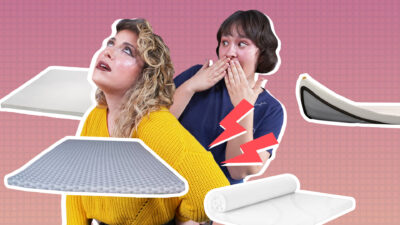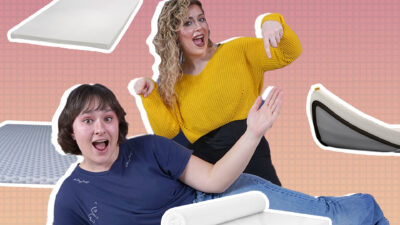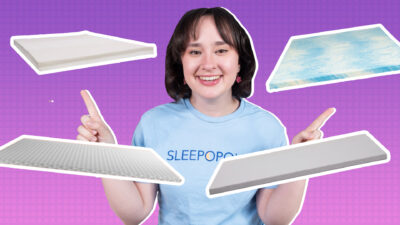Want to change the feel of your mattress without breaking the bank? Our roundup of the best mattress toppers is here to help. Adding a mattress topper to your bed can make it feel firmer or softer, and many of them even have additional features such as infusions of gel for cooling. At the bottom of the page, our buying guide discusses mattress topper materials, mattress topper pros and cons, and how to select the best mattress topper for your individual needs.
Best Mattress Toppers of 2024
- Best Overall – Nolah Mattress Topper
- Best Luxury – Saatva Mattress Topper
- Best for Side Sleepers – ViscoSoft Select High Density Mattress Topper
- Best Budget Topper – Brooklyn Bedding Gel Swirl Mattress Topper
- Best Memory Foam – Puffy Mattress Topper
- Best Mattress Topper for Combo Sleepers – Coop Sleep Goods Retreat Topper
- Best Topper Made In the USA – Tempur-Pedic TEMPUR-Adapt Mattress Topper
- Best Down Alternative Mattress Topper – Brooklinen Down Alternative Mattress Topper
- Best Plush Mattress Topper – Parachute Down Topper
- Best for Back Sleepers – Layla Mattress Topper
Video Review: Best Mattress Toppers

Best Overall – Nolah Mattress Topper
Nolah Mattress Topper
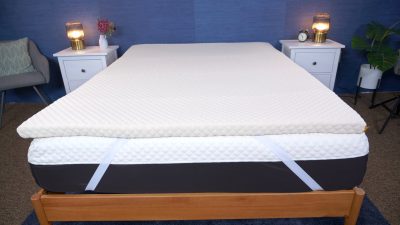
The Nolah Mattress Topper is a high-quality product boasting a CertiPUR-US certification. Nolah's signature foam is described as more durable, plush, and cooling than other foams on the market.
Sleepopolis Score
4.90 / 5





Read Full Review
The Nolah mattress topper is our favorite topper for many reasons. This American-made topper is comfortable, supportive, and cooling. The company also offers two options: Plush and Luxury Firm. You can select which model is based on your body type and sleeping position.
Why We Love This Topper
- Hot sleepers should enjoy the moisture-wicking properties of Nolah’s proprietary AirFoam.
- The topper has an organic cotton-blend cover and CertiPUR-US certified foam.
- This cover comes with elastic bands so it won’t slip around on your mattress.
Keep In Mind
- While it does have high-quality materials, it’s not the cheapest option on the market.
Read our full Nolah mattress topper review to learn more.
Best Luxury – Saatva Graphite Mattress Topper
Saatva Graphite Mattress Topper
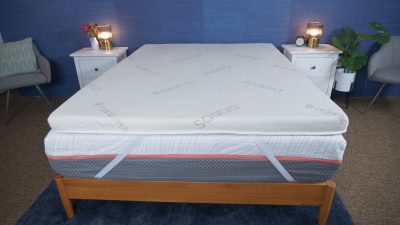
This high-quality topper is made with an organic cotton cover, graphite-infused memory foam, and elastic straps.
Sleepopolis Score
4.80 / 5





Read Full Review
The Saatva mattress topper is a great luxury option and comes in three variations: graphite, latex, and classic memory foam. We chose the high-quality graphite Saatva mattress topper, as the memory foam gives comfortable contouring and the graphite infusions provide cooling. This topper also features an organic cotton cover and straps to secure it to your mattress.
Why We Love This Topper
- Three inches of foam allow for pressure relief, which is ideal for back and side sleepers.
- The graphite infusions draw heat away from the body and the breathable cotton cover allows for airflow. This is crucial for hot sleepers.
- Saatva includes a 180-night trial, a 1-year limited warranty, and free shipping.
Keep In Mind
- The Saatva mattress topper is a high-quality luxury option, so it’s fairly expensive.
Read our full review for the Saatva Graphite Mattress Topper.
Best for Side Sleepers – ViscoSoft Select High Density Mattress Topper
ViscoSoft Select High Density Mattress Topper
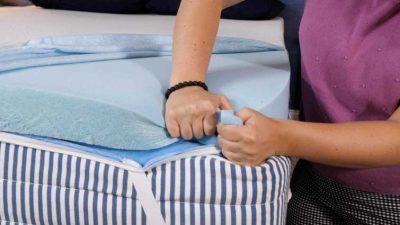
The ViscoSoft Select High Density mattress topper features high-density gel-infused foam with perforations for airflow, as well as a bamboo rayon cover and adjustable no-slip straps.
Sleepopolis Score
4.50 / 5





Read Full Review
Side sleepers looking for great support and pressure relief should enjoy the ViscoSoft Select High Density mattress topper. The dense memory foam is sturdy, but provides a soft and conforming feel. It helps keep your spine aligned when you’re sleeping on your back or side.
Why We Love This Topper
- The ViscoSoft’s “on top of the bed” feel should help combination sleepers easily switch sleeping positions.
- Hot sleepers should appreciate the bamboo rayon cover and gel-infused memory foam that promote cooling and temperature regulation.
- This topper has no-slip straps to keep it in place even if you toss and turn at night.
Keep In Mind
- The ViscoSoft topper may not be firm enough to maintain the spinal alignment of stomach sleepers.
Read our full ViscoSoft Select High Density Mattress Topper review.
Best Budget Topper – Brooklyn Bedding Gel Swirl Memory Foam Mattress Topper
Brooklyn Bedding Gel Swirl Mattress Topper
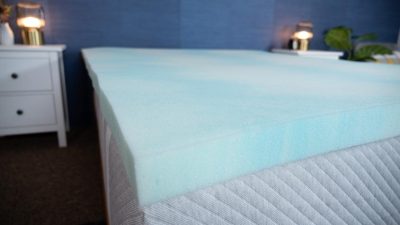
The Brooklyn Bedding Gel Swirl Topper is made with a 2.5-pound layer of gel memory foam pairs ultimate optimal pressure point relief with just the right amount of responsiveness.
Read Full ReviewIf you’re shopping on a budget, the Gel Swirl Memory Foam mattress topper from Brooklyn Bedding is a great option. It’s often priced at less than $100 for a queen and is available in 2-inch and 3-inch thicknesses, so you can choose the best option based on your sleep position and overall preferences.
Why We Love This Topper
- It’s great for back and side sleepers, who need additional comfort and contouring.
- The gel infusions keep the heat-trapping memory foam temperature-neutral, which is great news for hot sleepers.
- This topper is CertiPUR-US certified, so it meets rigorous standards for content and emissions.
Keep In Mind
- This topper doesn’t include straps to attach to the bed. So, those who toss and turn a lot may find this topper shifts a bit on the mattress surface.
Read our full Brooklyn Bedding Gel Swirl Memory Foam Mattress Topper review.
Best Memory Foam – Puffy Mattress Topper
Puffy Deluxe Mattress Topper
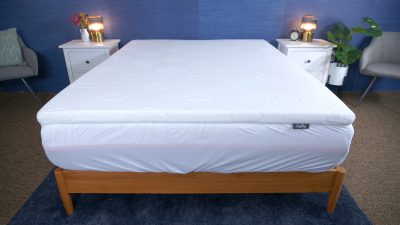
The Puffy mattress topper is a great solution for those looking to firm up a soft mattress, or soften a firm mattress! It has an anti-slip grip to keep it from falling off your bed.
Sleepopolis Score
5.00 / 5





Read Full Review
Memory foam is a great mattress topper material because it provides cushioning, contouring, and pressure relief. What better option than the Puffy topper? It’s high-quality and includes two and a half inches of foam. Since it’s available in either a Firm or Soft version, you can choose what’s best for you and your mattress.
Why We Love This Topper
- The Puffy topper’s cover includes bamboo viscose. Bamboo is known for its temperature regulation and cooling properties.
- Its skirt attaches to the cover, securing the topper to your mattress like a fitted sheet. This is ideal for those who toss and turn, as it will help to prevent the topper from shifting.
- Puffy offers a lifetime warranty on this topper.
Keep In Mind
- If you don’t like a slow-moving memory foam feel, this topper isn’t for you.
Read our full Puffy Mattress Topper review.
Best Mattress Topper for Combination Sleepers – Coop Sleep Goods Retreat Topper
Coop Sleep Goods Retreat Mattress Topper
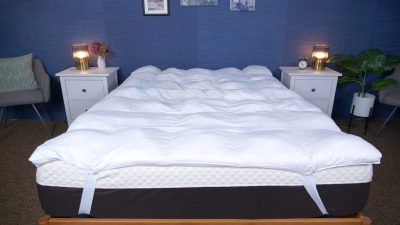
This Coop Sleep Goods topper is filled with cross-cut foam and microfibers, using a baffle box construction for even distribution.
Sleepopolis Score
4.90 / 5





Read Full Review
Because they change positions at night, combination sleepers move around in their sleep more than other folks. That means they’re going to want a mattress topper that stays secured to the bed. Luckily, the Coop Sleep Goods Retreat topper has elastic straps that bind it to the top of the mattress. Combo sleepers can rest assured that this topper won’t be going anywhere.
Why We Love This Topper
- Overall, it has a soft feel that’s like a cross between down and traditional memory foam.
- This topper is filled with shredded foam and it has baffle box construction, which prevents clumping and keeps the filling evenly spaced out (another plus for cooling and airflow).
- The pockets of shredded foam fill give this topper a pillow top feel, which adds a pleasant feel to the mattress.
Keep In Mind
- You’ll have to spot-clean this topper, rather than put it in the washer. Afterward, you’ll need to air-dry it.
Read our full Coop Home Goods Retreat mattress topper review.
Best Topper Made In the USA – TEMPUR-Adapt Topper
TEMPUR-Adapt Mattress Topper
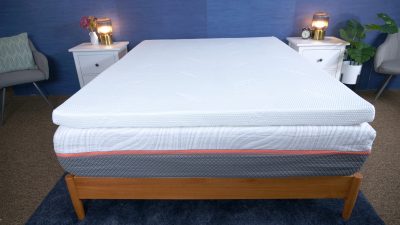
The TEMPUR-Adapt is a great mattress topper with a soft memory foam feel that offers impressive pressure relief!
Sleepopolis Score
4.50 / 5





Read Full Review
Tempur-Pedic is renowned for its TEMPUR material — a proprietary version of memory foam that provides extra sinkage, contouring, and overall cuddliness. It’s found in Tempur-Pedic mattresses, as well as the TEMPUR-Adapt Topper. It should be a great fit for back sleepers and side sleepers alike, giving them just the right blend of pressure relief and support. And as an added bonus, this mattress topper is made in the United States. Many consumers prefer American-made products, as purchasing them supports their country’s economy.
Why We Love This Topper
- It’s a thick, dense topper that really gives you that classic memory-foam hug.
- The cover is removable and machine-washable.
- It’s available in six different sizes, including twin, full, queen, and king.
Keep In Mind
- Due to its softness, this probably isn’t going to be the best mattress topper for stomach sleepers. They’re going to need something with more support and less sinkage.
Read our full Tempur-Pedic TEMPUR-Adapt Mattress Topper review.
Best Down Alternative Mattress Topper – Brooklinen Down Alternative Mattress Topper
Brooklinen Down Alternative Mattress Topper
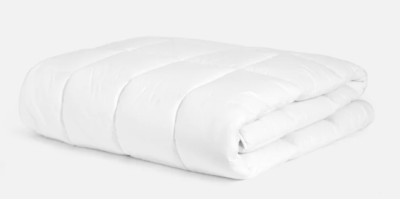
The Brooklinen Down Alternative Topper is a cooling gel-infused, hypoallergenic, animal-friendly alternative to traditional down toppers.
Brooklinen’s Down Alternative mattress topper is designed to be thin enough to maintain the original firmness of your bed, while also adding some plushness and a fluffier feel overall. This topper includes microgel fill — an especially soft and silky material — underneath a tufted construction, which should make sure that this fill is evenly distributed throughout the topper. The Brooklinen Down Alternative topper is also encased in a 100 percent cotton shell, making sure that this topper adds softness and comfort without increasing the temperature in your bed. As a down alternative, this bed does not use any feathers in its construction, but it should still provide that featherbed-like feel, while also being hypoallergenic.
Why We Love This Topper
- The Brooklinen Down Alternative topper includes a waterproof barrier at the bottom to increase the longevity and cleanliness of your mattress.
- The stretched skirt included on this topper allows it to fit snuggly on mattresses up to 18 inches deep.
- Because the Brooklinen Down Alternative topper does not contain feathers, it can be machine washed on cool and put in the dryer on low.
Keep In Mind
- While the Brooklinen Down Alternative topper can be returned for up to 365 days, all returns are subjected to a $9.95 fee.
Our full review for the Brooklinen Down Alternative mattress topper is coming soon.
Best Plush Mattress Topper – Parachute Down Topper
Parachute Down Mattress Topper
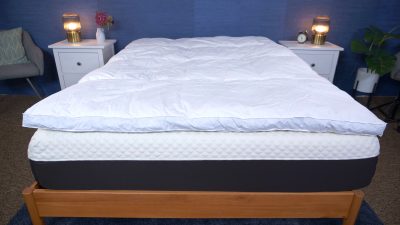
This mattress topper has two layers of down and feathers, creating an especially plush sleeping experience.
Sleepopolis Score
4.30 / 5





Read Full Review
If you’re looking for a plush mattress topper, down is one of the softest materials out there. Down is soft, spineless bird feathers that give you plenty of fluffiness while also being somewhat moldable. If this sounds up your alley, then you should check out the Parachute Down topper. Three inches thick, it has two layers of both down and feathers that should wrap your body in softness as soon as you hit the mattress.
Why We Love This Topper
- Its baffle box stitching keeps the down and feather filling evenly spread out.
- The mattress topper’s shell is made from 100 percent cotton.
- It has a 500 power fill.
Keep In Mind
- This mattress topper is dry-clean only, so you won’t be able to wash it at home.
Read our full Parachute Down mattress topper review to learn more.
Best for Back Sleepers – Layla Mattress Topper
Layla Mattress Topper
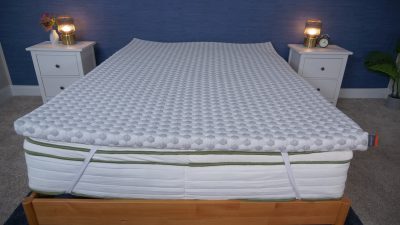
A memory foam topper from Layla is a great way to extend the life of your current mattress.
Sleepopolis Score
4.20 / 5





Read Full Review
With a balanced feel, the Layla mattress topper is ideal for back sleepers. It includes cushioning foam for pressure relief but it is thick enough to support the lumbar region. A blend of polyester, viscose, and lycra, the cozy cover is first to greet sleepers when they curl up on this topper.
Why We Love This Topper
- It includes straps to fix it to the topper and prevent it from sliding.
- The copper infusions in the foam of the Layla topper draw heat away from the body, keeping the topper temperature-neutral.
- Its cover is removable and machine-washable.
Keep In Mind
- Heavier sleepers will likely need a thicker topper. We think they’ll compress through the layers of the Layla topper too easily.
Read our full Layla Mattress Topper review.
Our Methodology
Now that you’ve read about our picks for the best mattress toppers, we’d like to share a little bit about the process our experts used to select them.
Here at Sleepopolis, our team of Certified Sleep Science Coaches has reviewed more than 220 products in our mattress lab, reviewing and analyzing them through a series of tests. With our roundup of the Best Mattress Toppers, we looked primarily at the following categories: quality of materials, durability, and trial and warranty. We feel confident there’s an excellent topper here for everyone. Click here to learn more about our methodology.
What is a Mattress Topper?
A mattress topper is an accessory used to add extra comfort layers to your mattress and fine-tune your bed’s firmness. They’re often one to four inches thick, come in a variety of materials, and can even regulate your body temperature. Most sleepers add toppers to a bed that’s uncomfortably firm, but you can add thick toppers to soft or worn mattresses.
What’s the Difference Between Mattress Toppers, Mattress Pads, and Mattress Protectors?
Mattress toppers are often confused with mattress pads and mattress protectors. A mattress topper is a thick piece of foam or pillow-top material that goes underneath your mattress pad or protector. On the other hand, a mattress pad is a thinner material attached to straps or a fitted sheet. It goes on top of your mattress for additional comfort, but isn’t as thick as a mattress topper. For larger firmness changes, we recommend a topper.
A mattress protector doesn’t include padding. It’s used to protect a mattress from spilled liquids and contaminants like allergens, bed bugs, and dust mites. Most mattress protectors zip onto a mattress and are easily removable and machine-washable. There are many good mattress protectors available, so you can choose one with features that meet your needs.
Recommended: Do I Need a Mattress Pad or Mattress Protector
Mattress Topper Materials
You’ll want to choose materials that provide the best comfort and support for your go-to sleeping position. Think of your topper as a mini mattress; the materials and construction will determine how it feels. Below, we’ll go over the most common mattress topper materials and how they impact a mattress’s feel.
Memory Foam Mattress Toppers
Memory foam is one of the most popular mattress topper materials available. In fact, we have a whole roundup dedicated to the best memory foam mattress toppers! This material is ideal for side and back sleepers wanting to make a firm mattress softer. It has a slow response to pressure and offers deep sinkage and body-contouring.
These toppers can also help reduce motion transfer, so it’s ideal for couples who don’t want to wake each other up at night. If you’re looking for a long-lasting topper, high-density memory foam is a great option for you.
Keep in mind memory foam has a reputation for overheating. Find memory foam toppers with cooling innovations, such as cooling gel infusions, which aim to break this stereotype.
Latex Mattress Toppers
If you’re looking for a cooling mattress topper, you might want to consider a latex topper. Latex is an excellent natural option for hot sleepers. It’s also hypoallergenic!
This material is bouncy, so combination sleepers should like the mobility it adds to a mattress. Stomach sleepers looking for a firmer feel should choose Dunlop latex because it adds support to a sagging bed. Sleepers looking for a soft, cooling topper could enjoy a Talalay latex topper.
Poly foam Mattress Toppers
If you’re on a budget, consider high-quality poly foam. Like memory foam it adds pressure relief, but poly foam provides a bit more bounce. Its balanced feel appeals to back sleepers especially.
Down / Down Alternative Mattress Toppers
If you like the plush feel of a feather bed, a down feather (or down alternative) mattress topper might be a good fit. The best down mattress topper will add cushioning and keep you warm at night, so it’s great for wintertime. Down alternatives avoid animal products, so they’re eco-friendly yet offer a similar feel.
Wool Mattress Toppers
Wool toppers add less cushioning than other materials (like down or memory foam), but they still create a soft feel. These toppers are good for temperature regulation; wool wicks away moisture in hot months, but keeps you cozy in colder months.
Mattress Topper Feel
How you’ll want your mattress topper to feel comes down to your body weight, your sleeping position, and your personal preferences.
Firmness
A topper’s firmness can vary depending on its materials. Bedding brands categorize toppers as soft, medium, or firm, it’s important to note this firmness is meant to complement your mattress feel, not change it entirely.
If you’re kicking yourself for buying a bed that’s slightly firm, try a soft topper and see if that balances the feel. With a bed that’s too soft, a memory foam topper or firm latex topper could keep your sleep surface supportive.
Thickness
Mattress toppers range in thickness, with most measuring between one to four inches. Take some time to determine how much depth you want to add. Remember a thicker topper will be pricier, but it will provide more pressure relief.
Heavier sleepers and/or side sleepers may find that a deep topper (three to four inches) relieves more pressure at sensitive areas like the hips and shoulders. Those looking to add a thin layer of comfort might be better off with the one to two-inch options. Check out our picks for the best mattress for heavy people for more!
Additional Mattress Topper Factors to Consider
Thermoregulation
Some toppers are designed to regulate your body temperature. If this appeals to you, check out toppers with Phase Change Material, copper, graphite, or gel infusions. You can also opt for a latex or wool topper.
Pressure Relief
Depending on your preferences, you’ll want more or less pressure relief from your topper. As a rule of thumb, thicker toppers offer more pressure relief. For this purpose, try a high-density memory foam topper.
Cover Fabric
Because toppers are designed to go beneath your fitted sheet, many exclude cover fabrics. However, you may want a cover fabric because it can protect your topper from contaminants. This can make wash care a bit simpler.
Fit
Mattress toppers fit beneath your fitted sheets. If you don’t have deep pocket sheets but don’t want to invest in a set, consider a thinner topper so your sheets stay on your bed.
Ensure that you get the right size topper for your existing mattress. Placing a topper on the wrong size bed can result in your topper sliding around at night. If you have the right size but you’re still worried about your topper slipping, opt for one with corner straps to keep it in place.
Price
Yes, toppers can be pricey (with most ranging from $100–$500), but remember that quality costs. To ease the purchasing pressure, find brands with generous trial periods and/or warranties. A trial period gives you time to decide if the topper is the right fit. A warranty ensures you’ll get a replacement topper if yours wears out more quickly than advertised.
Recommended: Best Cheap Mattress Topper
Which Mattress Topper is Best for Me?
So, how do you know which of these features to prioritize? Well, it depends on how you sleep. Take a look at the different sleeping positions below to learn more about choosing the right topper for your needs.
Side Sleepers
These sleepers should prefer a thick topper offering lots of pressure relief. Our best soft mattress toppers list provides some great plush options.
Back Sleepers
These folks could do well on almost any topper on this list, and it depends on the feel they prefer. As a reminder, memory foam offers contouring, down offers comfort, latex offers bounce, and wool offers a thin layer of pressure relief.
Stomach Sleepers
Because too much softness can throw one’s spine out of alignment, stomach sleepers do best on firm mattresses. Try one of our best firm mattress toppers, which should help keep the hips aligned with the shoulders.
Combination Sleepers
These sleepers need a topper that makes it easy to move around and change positions at night. One of our best latex mattress toppers, which offer plenty of mobility, could be a good fit.
Heavy Sleepers
People over 250 pounds can get less out of mattress toppers than light or average-weight sleepers because they can sink too far in the material. Opt for thick, high-density toppers with deep compression support. High-density latex or memory foam toppers might be good options.
Recommended: The Best Mattress Topper for Back Pain
When is it Time to Buy a Mattress Topper?
There are a few occasions when a topper might be useful:
- You’ve just bought a new mattress, but it’s too firm. A mattress topper can add some additional softness in this case.
- Your bed is feeling worn, saggy, or lumpy. If your bed is less comfortable than it used to be but you’re not ready to invest in a new mattress, a mattress topper can extend its life by up to a year.
- You’re waking up with pain. If you’re waking up with back, neck, or joint pain, a new mattress topper could help you sleep more comfortably. A pillow designed to fight neck pain could also be a good solution.
- You’re overheating at night. Believe it or not, a cooling topper can help regulate the temperature of your mattress. A set of our best cooling sheets might help as well.
- You’re struggling with allergies. If you struggle with dust allergies and are sleeping on an old mattress, your bed could be trapping those contaminants. Adding a hypoallergenic topper may help you breathe easier at night. One of our best latex mattress toppers (which are naturally hypoallergenic) is a great place to start.
Mattress Topper Pros and Cons
We hope these guidelines are helping you stay informed! To round things out, we’ll leave you with a few final pros and cons.
|
Pros |
Cons |
|
Cheaper way to change a mattress’s feel |
Often spot-clean only |
|
Enhances comfort |
Not as durable as a mattress |
|
Versatile feels and options |
May not fix drastic changes in feel |
|
Easy to transport |
Pros of a Mattress Topper
- Price: A new mattress topper is less expensive than a new mattress, making it a great way to upgrade your mattress on a budget. Compare prices across several different brands and use our coupons to get the best deal.
- Comfort: Toppers can enhance your mattress and make it feel more comfortable. They’re especially great options for those in need of additional pressure relief.
- Versatility: Mattress toppers have diverse feels and comfort options, so almost every sleeper should be able to find one that works for their needs.
- Transport: It’s much easier to move and store a topper than it is to move an entire mattress, so these accessories are ideal for upgrading beds you’ll use for a year or two.
Cons of a Mattress Topper
- Wash Care: Most mattress toppers are spot-clean only. If you feel nervous about damaging or dirtying your topper, we suggest you aim for one that comes with a removable, washable cover fabric. This will just provide an extra layer of protection for your fancy new sleep accessory.
- Durability: A topper isn’t as durable as a mattress (a new topper will last you one to four years). If you’re buying a new topper to increase the lifespan of your old mattress, keep in mind you’ll need to replace both pretty soon.
- Limitations: Mattress toppers are meant to enhance the feel of your existing mattress, not change it. If you’re truly unhappy with your current mattress, a topper isn’t going to fix it.
Well, that’s all we have for you! Best of luck on your topper-shopping journey, and don’t forget to subscribe to our YouTube channel and follow us on Facebook, Twitter, and Instagram for the answers to all your sleep questions.
FAQs
Do mattress toppers go under or over mattress pads?
Mattress toppers are meant to go underneath mattress pads and other bedding.
Do mattress toppers help?
Yes, mattress toppers can be a helpful addition to your bed! They can add cushioning pressure relief, help you sleep cooler, and protect against allergies. Some mattress toppers can also make your bed feel a little firmer.
Can I put two mattress toppers on top of each other?
No, you should only use one mattress topper at a time. If you’re looking for an extra-cushioning feel, opt for an extra-thick topper.
How thick should my mattress topper be?
It depends on your needs. If your mattress already offers fairly good pressure-relief and padding, a one to two inch topper should work for you. If your bed is very worn out or extremely firm, a three to four inch topper is probably a better pick.
Why is my foam mattress topper yellow?
Certain foams, especially memory foam, can turn yellow when exposed to light and air over a long period of time. This is nothing to be concerned about. If your mattress topper is yellowing because of dirt or sweat stains, I’d recommend spot-cleaning it the way you’d spot-clean a mattress.
Which type of mattress topper is best for back pain?
I’d recommend a firm memory foam topper to sleepers with back pain. It should offer them some nice pressure relief at the lower back.

